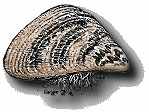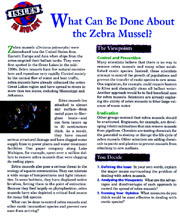.
Click
for a full-sized copy of this issue from page 700 of the Dragonfly
Book.
Click
Here to see a full-size scan
of 
Web
Resources on This topic:
The
Zebra Mussel Page (constructed by Jeffrey
L. Ram, Department of Physiology, Wayne State University)
This excellent resource highlights the output of a laboratory
concentrating on Zebra Mussel research. It contains excellent
graphics and fascinating information on the biology of these mollusks.
Zebra
Mussels and Other Nonindigenous Species (Sea
grant Great Lakes Program)
This site
provides an excellent introduction to the general issues of introduced
species with special reference to the Zebra Mussel Problem.
Potential
Control of Zebra Mussels Through Reproductive Intervention
This excellent
document, prepared by the Michigan Sea Grant College Program discusses
ways to control Zebra Mussels by interfering with their ability
to reproduce.
An
Animated Map of the Zebra Mussel Invasion
If you have
any doubts or questions about the speed with which an introduced
species can multiply and expand its range, check out this animated
map of the distribution of Zebra Mussels in the U.S. since they
were first detected in 1988.
This website,
belonging to Environmental Technologies Inc., describes the Zebra
Mussel problem, and offers their solution for monitoring and controlling
mussel populations under certain circumstances. (Note: this commercial
site is included for informational purposes only; its inclusion
does not indicate endorsement of this approach or company.)
Sea
Grant National Aquatic Nuisance Species Clearinghouse
This site
specifically describes and discusses, not only Zebra mussels,
but other aquatic invertebrates, fishes, and even birds. The number
of species on its list will surprise you – and these are
only the aquatic invaders that Sea Grant is especially interested
in!
Zebra
Mussel Information (United States Geological Survey)
Yet another
national organization concerned about the monitoring, spread,
and control of Zebra Mussels.
Zebra
Mussel Research Program (produced by the Army Corps of
Engineers)
Here is another
clearinghouse for information on Zebra Mussel Control programs.
Sea
Grant Education Products at Exotic Species Day Camp
Attention
teachers! Here is a collection of educational materials pertaining
to Zebra Mussels and other introduced species produced by the
Sea Grant Program. They are looking for instructors to test and
evaluate these materials.
|
. Click for a full-sized copy of this issue from page 700 of the Dragonfly Book. Click
Here to see a full-size scan
of
|
|
(A web site developed by Ken Miller and Joe Levine to provide scientific and education support for teachers and students using our textbooks)

